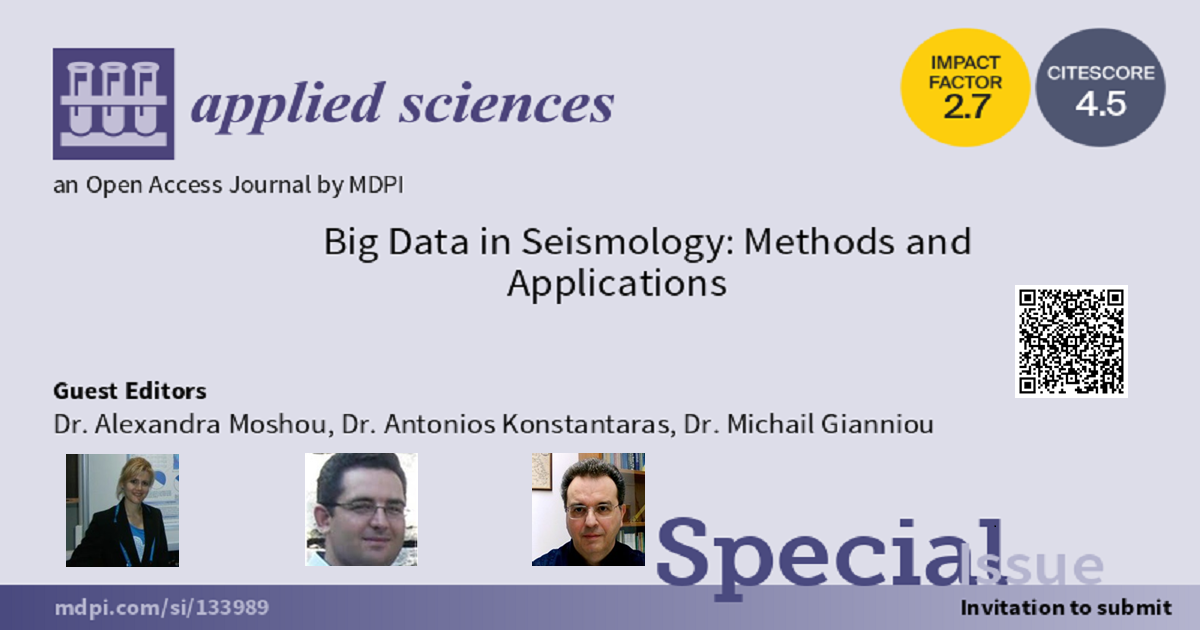Big Data in Seismology: Methods and Applications
A special issue of Applied Sciences (ISSN 2076-3417). This special issue belongs to the section "Earth Sciences".
Deadline for manuscript submissions: closed (30 September 2023) | Viewed by 8589

Special Issue Editors
Interests: seismic big data; deep learning; spatial data processing; seismic data processing; earth science informatics; analysis and visualization of earth science data; seismic sequences
Special Issues, Collections and Topics in MDPI journals
Interests: seismic big data; deep learning; heterogeneous parallel processing; spatio-temporal algorithms
Interests: geoinformatics; spatial data processing; geodetic satellite positioning; networks of permanent GNSS reference stations; geodetic reference systems; monitoring tectonic displacements with GNSS
Special Issue Information
Dear Colleagues,
We invite you to contribute to this Special Issue on Big Data in Seismology: Methods and Applications.
The term "Big Data" has grown in prominence over the last ten years. As a result, the field of big geospatial data has recently received considerable attention from various areas. This Special Issue outlines the development of big data theory and practice as a scientific area, as well as the key characteristics and processing strategies. For instance, big data sources in Earth sciences include meteorology, seismic exploration, and remote sensing. We also discuss seismic monitoring data, which can become big data combined with other geophysical data. In addition, researchers now have instant access to processing power thanks to cloud computing services.
Additionally, parallel and distributed computing enable scientists to run a variety of computations concurrently, frequently dispersed across multiple workstations. The utilization of data has played a significant role in geosciences. New potential for the extensive use of data in geosciences has emerged due to recent scientific and professional advancements in data collection in geosciences and data analysis using big data and machine learning.
Since the Mediterranean is a tectonic boundary zone between the African and European plates, it is a particularly seismically active region. Additionally, it is a highly populated area with significant seismic risk exposure. Applying approaches that seek to detect and analyze earthquakes would result in a rich and high-resolution dataset, which would, in turn, help shed more light on the underlying mechanisms. We aim to produce unique research publications regarding studies of earthquake swarms and complex seismic sequences in volcanic and tectonic environments to advance our understanding of the underlying physics of the processes at their genesis.
For this Special Issue, we encourage articles, reviews, and technical reports that combine theory and experiments to process seismic data using parallel computing and deep learning. Appropriate articles will discuss the most recent advancements and cutting-edge research in the geospatial big data field, with a focus on the following issues:
- Reporting and characterizing swarm-like and complex sequences in terms of spatial and temporal evolution, scaling properties, and triggering processes;
- Data selection and acquisition;
- Seismotectonic and seismicity of the region;
- Artificial intelligence and geoscience-based design methodologies (machine learning and deep learning);
- Data science's role in the geosciences' conventional and new issues;
- Needs and perspectives for the use of data in geosciences;
- Simulating the essential mechanical conditions resulting in rupture dynamics using laboratory and numerical models.
Dr. Alexandra Moshou
Dr. Antonios Konstantaras
Dr. Michail Gianniou
Guest Editors
Manuscript Submission Information
Manuscripts should be submitted online at www.mdpi.com by registering and logging in to this website. Once you are registered, click here to go to the submission form. Manuscripts can be submitted until the deadline. All submissions that pass pre-check are peer-reviewed. Accepted papers will be published continuously in the journal (as soon as accepted) and will be listed together on the special issue website. Research articles, review articles as well as short communications are invited. For planned papers, a title and short abstract (about 100 words) can be sent to the Editorial Office for announcement on this website.
Submitted manuscripts should not have been published previously, nor be under consideration for publication elsewhere (except conference proceedings papers). All manuscripts are thoroughly refereed through a single-blind peer-review process. A guide for authors and other relevant information for submission of manuscripts is available on the Instructions for Authors page. Applied Sciences is an international peer-reviewed open access semimonthly journal published by MDPI.
Please visit the Instructions for Authors page before submitting a manuscript. The Article Processing Charge (APC) for publication in this open access journal is 2400 CHF (Swiss Francs). Submitted papers should be well formatted and use good English. Authors may use MDPI's English editing service prior to publication or during author revisions.







